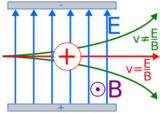
Learning Exercises and Remote Laboratories for Introductory Physics
- Subject:
- Physics
- Material Type:
- Activity/Lab
- Author:
- Robert Greeney
- Date Added:
- 03/26/2020

Learning Exercises and Remote Laboratories for Introductory Physics
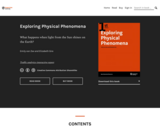
What happens when light from the Sun shines on the Earth?
Short Description:
This course is intended for prospective and practicing elementary and middle school teachers. By exploring physical phenomena in class, you will learn science in ways in which you are expected to teach science in schools or in informal settings such as afterschool programs, youth group meetings, and museum workshops. This course also is appropriate for general science students and others interested in exploring some of the physical phenomena underlying global climate change. Data dashboard
Word Count: 178063
(Note: This resource's metadata has been created automatically by reformatting and/or combining the information that the author initially provided as part of a bulk import process.)

Updated Fall 2023
This textbook was designed especially for Community College students, as a resource to instill the knowledge and adventure that the discipline of geography holds for so many of us. The following units will cover a wide array of topics such as: Earth’s grid system, weather, climate, rivers, oceans, deserts, basic geology, and cartography. This book also integrates virtual field trips and interactive multimedia.
The Text Has 19 units;
Unit 1: Introduction to Geography as a Discipline
Unit 2: Earth’s Place within the Cosmos
Unit 3: Introduction to Geology & Geologic Time
Unit 4: Mapping Earth’s Surface
Unit 5: Earth-Sun Relationships: Reasons for the Seasons
Unit 6: Earth’s Atmosphere
Unit 7: Elements of Weather & Climate
Unit 8: Basic Mineral Development
Unit 9: Igneous Rocks
Unit 10: Sedimentary Rocks
Unit 11: Metamorphism & Metamorphic Rocks
Unit 12: Weathering & Soils
Unit 13: Earths Dynamic Surface: Plate Tectonics
Unit 14: Earths Dynamic Surface: Tectonics Force
Unit 15: Earths Dynamic Surface: Volcanoes
Unit 16: Shaped by Coastal Processes
Unit 17: Shaped by Rivers & Running Water
Unit 18: Shaped by Wind as a Geomorphic Agent
Unit 19: Shaped by Glaciers
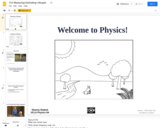
Physics Chapter 1 slides
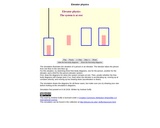
The simulation illustrates the situation of a person in an elevator. The elevator takes the person from one floor to the next floor up.
For this situation, try sketching three free-body diagrams, one for the person, another for the elevator, and a third for the person-elevator system.
First, draw the diagrams for when the system remains at rest. Then, predict whether the free-body diagrams will change (and, if so, how) when the elevator is accelerating up, moving up at constant velocity, and moving up but slowing down (acceleration is down).
The simulation draws the diagrams for all these cases, but make sure you try drawing your own before looking at the simulation's diagrams.
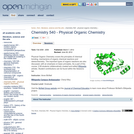
Chemistry 540 - Physical Organic Chemistry covers the principles of chemical bonding, mechanisms of organic chemical reactions and stereochemistry. The important types of organic reactions are also discussed, with an emphasis on basic principles. As a part of this course, U-M students collaboratively created and editedWikipedia÷articles. Student contributions can be found below, within the "Wikipedia Articles" section.
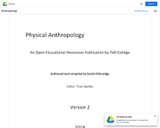
Textbook for ANTH 101: Introduction to Physical Anthropology at College of the Canyons
Examines the evolution of the human species and non-human primates primarily from the biological perspective. Topics include human heredity and population genetics, primate behavior and conservation, the human fossil record, and modern human variation.

This is the first course in the undergraduate Quantum Physics sequence. It introduces the basic features of quantum mechanics. It covers the experimental basis of quantum physics, introduces wave mechanics, Schrödinger's equation in a single dimension, and Schrödinger's equation in three dimensions. The lectures and lecture notes for this course form the basis of Zwiebach’s textbook Mastering Quantum Mechanics published by MIT Press in April 2022.
This presentation of 8.04 by Barton Zwiebach (2016) differs somewhat and complements nicely the presentation of Allan Adams (2013). Adams covers a larger set of ideas; Zwiebach tends to go deeper into a smaller set of ideas, offering a systematic and detailed treatment. Adams begins with the subtleties of superpostion, while Zwiebach discusses the surprises of interaction-free measurements. While both courses overlap over a sizable amount of standard material, Adams discussed applications to condensed matter physics, while Zwiebach focused on scattering and resonances. The different perspectives of the instructors make the problem sets in the two courses rather different.
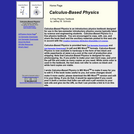
A free, two-volume, on-line, editable, introductory calculus based physics textbook in PDF™ and Microsoft Word™ format. Also provides ancillary materials including video solutions to physics problems and Blackboard™ quizzes with extensive feedback.

In these videos from Spring 2022, Dr. Mahmoud Hammouri in provides illustrative examples for students to use while completing assignments. Examples include: Vertical motion example 1; Vertical motion example 2; Projectile motion example; Try it: projectile motion; Vectors review; Vector addition part 1; Vector addition part 2; Try it: Vectors; Horizontal motion example 1; Horizontal example 2; Try it: horizontal motion; Distance and displacement; Try it: distance and displacement; Newton's 2nd law applications: Example 1; Newton's 2nd law applications: Example 2; Newton's 2nd law applications: Example 3; Newton's 2nd law applications: Example 4 part 1; Newton's 2nd law applications: Example 4 part 2; Work and kinetic energy examples; Loop-the-loop track example; Spring-mass system example; Try it: Mass-spring system; Mass-spring system; Try it: Runaway truck; Solid and hollow spheres sliding without slipping; Atwood's machine; Acceleration of a rolling sphere; Primitive yo-yo; Collision of two pucks
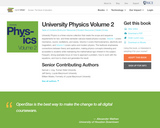
University Physics is a three-volume collection that meets the scope and sequence requirements for two- and three-semester calculus-based physics courses. Volume 1 covers mechanics, sound, oscillations, and waves. Volume 2 covers thermodynamics, electricity and magnetism, and Volume 3 covers optics and modern physics. This textbook emphasizes connections between theory and application, making physics concepts interesting and accessible to students while maintaining the mathematical rigor inherent in the subject. Frequent, strong examples focus on how to approach a problem, how to work with the equations, and how to check and generalize the result.
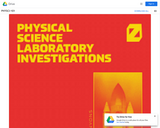
Lab manual for Introduction to Physics. This course is an introduction to the major concepts in physics, filled with relevant information of our scientific and technological age that every voting member of our society should know. We will cover both classical and modern physics; including physical principles concerning motion, gravity, heat, light, sound, electricity, magnetism, the atom, the nucleus, relativity, and quantum mechanics.

This course covers probability distributions for classical and quantum systems. Topics include: Microcanonical, canonical, and grand canonical partition-functions and associated thermodynamic potentials. Also discussed are conditions of thermodynamic equilibrium for homogenous and heterogenous systems.
The course follows 8.044, Statistical Physics I, and is second in this series of undergraduate Statistical Physics courses.
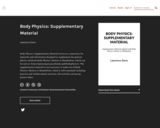
Short Description:
Body Physics: Supplementary Material serves as a repository for materials and information designed to supplement the general physics textbook Body Physics: Motion to Metabolism, which can be seen at: https://openoregon.pressbooks.pub/bodyphysics/. The supplementary material is not necessary to make use of Body Physics: Motion to Metabolism, which is self-contained including practice and reinforcement exercises, lab activities and group project ideas.
Long Description:
Body Physics: Supplementary Material serves as a repository for materials and information designed to supplement the general physics textbook Body Physics: Motion to Metabolism, which can be seen at: https://openoregon.pressbooks.pub/bodyphysics/. The supplementary material is not necessary to make use of Body Physics: Motion to Metabolism, which is self-contained including practice and reinforcement exercises, lab activities and group project ideas. Supplementary material includes: additional lab activities; content created by students through open pedagogy assignments; conference presentations about the design, development, and use of Body Physics; and research related to the use, assessment, and improvement of Body Physics (coming soon).
Word Count: 60301
(Note: This resource's metadata has been created automatically by reformatting and/or combining the information that the author initially provided as part of a bulk import process.)

This course presents an introduction to quantum mechanics. It begins with an examination of the historical development of quantum theory, properties of particles and waves, wave mechanics and applications to simple systems — the particle in a box, the harmonic oscillator, the rigid rotor and the hydrogen atom. The lectures continue with a discussion of atomic structure and the Periodic Table. The final lectures cover applications to chemical bonding including valence bond and molecular orbital theory, molecular structure, spectroscopy.
Acknowledgements
The material for 5.61 has evolved over a period of many years, and, accordingly, several faculty members have contributed to the development of the course contents. The original version of the lecture notes that are available on OCW was prepared in the early 1990's by Prof. Sylvia T. Ceyer. These were revised and transcribed to electronic form primarily by Prof. Keith A. Nelson. The current version includes additional contributions by Professors Moungi G. Bawendi, Robert W. Field, Robert G. Griffin, Robert J. Silbey and John S. Waugh, all of whom have taught the course in the recent past.

This is a “minimalist” textbook for a first semester of university, calculus-based physics, covering classical mechanics (including one chapter on mechanical waves, but excluding fluids), plus a brief introduction to thermodynamics. The presentation owes much to Mazur’s The Principles and Practice of Physics: conservation laws, momentum and energy, are introduced before forces, and one-dimensional setups are thoroughly explored before two-dimensional systems are considered. It contains both problems and worked-out examples.

8.06 is the third course in the three-sequence physics undergraduate Quantum Mechanics curriculum. By the end of this course, you will be able to interpret and analyze a wide range of quantum mechanical systems using both exact analytic techniques and various approximation methods. This course will introduce some of the important model systems studied in contemporary physics, including two-dimensional electron systems, the fine structure of Hydrogen, lasers, and particle scattering.

This freshman-level course is the second semester of introductory physics. The focus is on electricity and magnetism. The subject is taught using the TEAL (Technology Enabled Active Learning) format which utilizes small group interaction and current technology. The TEAL/Studio Project at MIT is a new approach to physics education designed to help students develop much better intuition about, and conceptual models of, physical phenomena.
Staff List
Visualizations:
Prof. John Belcher
Instructors:
Dr. Peter Dourmashkin
Prof. Bruce Knuteson
Prof. Gunther Roland
Prof. Bolek Wyslouch
Dr. Brian Wecht
Prof. Eric Katsavounidis
Prof. Robert Simcoe
Prof. Joseph Formaggio
Course Co-Administrators:
Dr. Peter Dourmashkin
Prof. Robert Redwine
Technical Instructors:
Andy Neely
Matthew Strafuss
Course Material:
Dr. Peter Dourmashkin
Prof. Eric Hudson
Dr. Sen-Ben Liao
Acknowledgements
The TEAL project is supported by The Alex and Brit d'Arbeloff Fund for Excellence in MIT Education, MIT iCampus, the Davis Educational Foundation, the National Science Foundation, the Class of 1960 Endowment for Innovation in Education, the Class of 1951 Fund for Excellence in Education, the Class of 1955 Fund for Excellence in Teaching, and the Helena Foundation. Many people have contributed to the development of the course materials. (PDF)
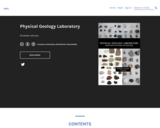
The purpose of this “book” is to help students practice skills to master learning objectives for physical geology laboratory. Includes H5P interactive exercises for students to self-test knowledge.